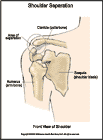
Shoulder Separation
What is a shoulder separation?
A shoulder separation occurs when you tear the ligaments that hold your collarbone (clavicle) to the joint where it meets the shoulder blade. Your collarbone may move out of its normal place and push up the skin on the top of your shoulder. Another term for shoulder separation is acromioclavicular (AC) separation or sprain.
Shoulder separations, or sprains, are graded I, II, or III, depending on how far the collarbone is separated from the shoulder. A grade I sprain has tenderness but no actual separation. A grade II sprain has slight separation of the clavicle from the shoulder, and grade III has a greater separation.
How does it occur?
A shoulder separation can result from a blow to your shoulder or a fall on your shoulder. It also can result from a fall on your outstretched hand or arm. It is a common injury in contact sports such as football, rugby, hockey, or lacrosse. It may occur from falling onto a hard surface, such as might happen during downhill skiing, volleyball, rock climbing, and soccer.
What are the symptoms?
Symptoms include the following:
- severe pain at the moment the injury occurs
- limited shoulder movement and tenderness on top of your shoulder at the end of your collarbone
- swelling and bruising of your shoulder area
- a misshapen shoulder.
How is it diagnosed?
Your health care provider will examine your shoulder for tenderness and a bump over the tip of your collarbone.
To make sure it is an AC separation and not a fracture, x-rays are necessary.
How is it treated?
Immediately after your injury put an ice pack on your shoulder for 20 to 30 minutes. Continue to put ice on your shoulder every 3 to 4 hours for the first 2 to 3 days, then as needed for the next several weeks. Cold helps reduce the pain, swelling, and inflammation.
The treatment of your separated shoulder depends on the severity. Grade I separations and some grade II and grade III separations may be placed in a sling or shoulder immobilizer. The sling or immobilizer will keep you from lifting your arm away from your chest and help healing of the ligaments. Your shoulder will be immobilized until you are pain free. Then you will begin rehabilitation exercises. Your health care provider may prescribe an anti-inflammatory medication or other pain medication.
For most grade II and grade III separations treatment is the same. However, in some situations surgery may be needed to reposition the bones or repair torn ligaments. Your arm will then be in a sling for up to 6 weeks to allow healing before you begin rehabilitation exercises. You should consult an orthopedic surgeon if you have a severe grade III injury.
How long will the effects of a shoulder separation last?
Some separations heal by themselves in 2 to 4 weeks without any loss of shoulder use. However, sometimes slight stiffness or loss of movement in the shoulder may occur, which may be temporary or, rarely, long-lasting.
A severe separation may take 2 months or more to heal, particularly if you have surgery to repair it.
You may have a permanent bump over your shoulder joint after a separation regardless of treatment. The bump does not normally cause other medical problems.
How can I take care of myself?
- Avoid participating in sports until the injury has healed.
- You should move your shoulder as the pain subsides to prevent a frozen or stiff shoulder.
- With your health care provider's permission, work with a trainer or physical therapist to strengthen your shoulder.
When can I return to my sport or activity?
The goal of rehabilitation is to return you to your sport or activity as soon as is safely possible. If you return too soon you may worsen your injury, which could lead to permanent damage. Everyone recovers from injury at a different rate. Return to your sport will be determined by how soon your shoulder recovers, not by how many days or weeks it has been since your injury occurred.
You may safely return to your sport or activity when:
- Your injured shoulder has full range of motion without pain.
- Your injured shoulder has regained normal strength compared to the uninjured shoulder.
In throwing sports, you must gradually build your tolerance to throwing. This means you should start with gentle tossing and gradually throw harder. In contact sports, your shoulder must not be tender to touch and contact should progress from minimal contact to harder contact.
What can I do to help prevent recurring shoulder separation?
Exercise and lift weights under the supervision of a trainer or physical therapist to strengthen your shoulder muscles. Muscle-strengthening exercises will also help strengthen your ligaments and tendons. If you have symptoms, you should avoid activities that aggravate your pain, use ice packs, and take anti-inflammatory medication if needed.

